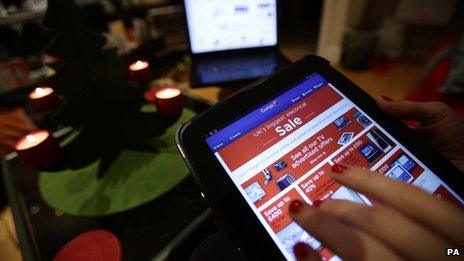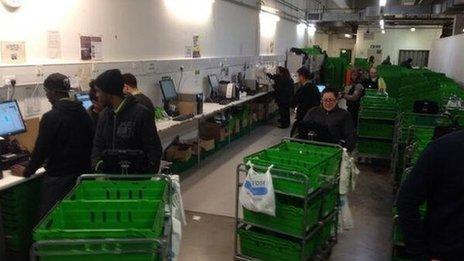Retail revolution: Online's promise and challenges
- Published

Online is key to retailers but as internet shopping grows so will the challenges
One notable theme emerged this Christmas: the number of gifts opened far outstripped any other December - and that's even before it got to Christmas morning.
That's because there were a record number of items bought online in December, many of which had to be opened in advance, examined and wrapped up again.
This was the year in which online sales wagged the entire retailing dog.
And the unprepared are being left behind.
"We're seeing a polarisation in the market from those retailers that have invested heavily in online and multichannel from those that have arrived later in the game," says Richard Lim, head of business information at the British Retail Consortium (BRC), which represents 80% of retailers.
In the food sector for instance, Tesco, where overall sales fell more than 2%, saw online sales rise 14%. At rival Sainsbury's, overall sales grew by 0.2%, but online rose by 10%.
In comparison, Morrisons, which has only just joined the online revolution this week, 13 years after Tesco sent out its first online shop, saw sales fall by 5.6%.
Online 'monster'
But as online grows, so do the problems that come with it.
"The challenge is: 'how do I deal with the monster I created?'" says Chris Donnelly, global managing director of Accenture's retail business.
Hardeep Singh Garewal, from IT providers, ITC Infotech, highlights one area for improvement: "Large swathes of retailers' [online] customers are unknown to them, in some cases, up to 85%."
He says many retailers simply do not know why their customers chose certain products, but they need to know this, because "retaining and selling to existing customers is far easier than attracting new ones".

Next has deep experience in home delivery as well as traditional retailing
Clothes retailers have another headache: it is common for three in 10 items "sold" to end up as returns as customers "buy" different colours and sizes to experiment with at home.
Mr Donnelly says: "In the early days it didn't really matter. If you were only doing 2% of your business online, too many returns didn't matter. Now, that could be a flood."
Experienced retailers like Next, a long-term success story in pre-internet mail order, know this. Next does not even count a third of the goods that leave its warehouses as officially sold.
'Dark stores'
Jonathan Reynolds: "Big expansion" in number of dark stores being opened
For food retailers, the bigger problem is profit margins. Clothing can carry a 50% profit margin, but in food 5% is more realistic, and although customers may pay for deliveries, that does not always cover costs.
One way round this for food retailers is to service online orders from "dark stores", which mirror outlets used by customers, but whose aisles are only used by staff picking out customer orders.
Sainsbury's is opening its first dark store soon and the property specialists Jones Lang LaSalle expects supermarkets to commit to doubling the space they commit to these typically large, anonymous buildings in 2014.

Supermarkets are increasingly turning to "dark stores" where the only shoppers are staff fulfilling internet orders
Mr Donnelly says this online growth will put pressure on the big four supermarkets' existing stores: "As online picks up, the profitability of physical stores declines. That's a bigger problem for grocers - other retailers have smaller stores and their lease terms are more flexible."
But Mark Hudson, head of retail at the consultants PricewaterhouseCoopers (PwC), does not think the big, out of town superstores' days are over.
"What they're doing is finding ways to make their stores a destination, adding services such as photographic, banking, even pet grooming, as well as providing restaurants and other leisure services," he says.
'Digital natives'
The rise of "click and collect", meanwhile, has highlighted the importance of the interaction between virtual space and physical space, as customers order online and pick up their items in store.
That is something where retailers need to join up the dots. It has been known for a click and collect customer to attempt to pick up an item, say, a shirt, that has not arrived, which turns out to be in the store - but the staff do not then offer the piece off the rack.
Mark Hudson says one future "mega trend", broadly speaking, boils down to service levels: "Make it a seamless experience - be good to them whether they're browsing, shopping or collecting in store."
However it is managed, online can only grow as the next generation are all "digital natives" who do not know anything else, he says.
The BRC's Richard Lim, adds: "Our figures show that around 20% of all non-food spending is online and we're expecting this number to continue to rise.
"Retail is going through one of the most rapidly evolving phases in its history, but there's no one 'silver bullet' for all business models to adopt."
Take discount supermarkets Aldi and Lidl, for example. They did record business this Christmas without even a whisper of a keyboard click.
But what is clear is that if a retailer is in the online game, they need to play it right.
- Published10 January 2014
- Published9 January 2014
- Published9 January 2014
- Published9 January 2014
- Published11 November 2013